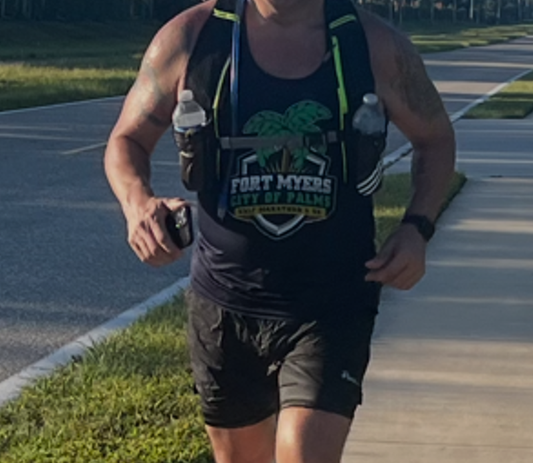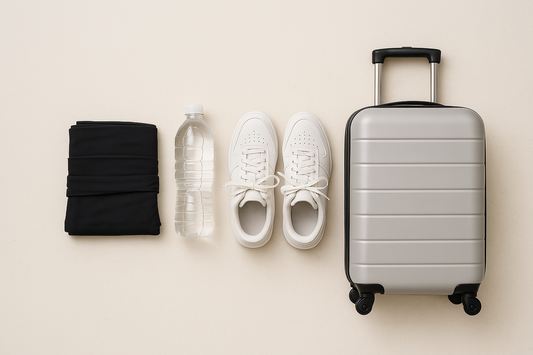Small Changes, Big Results: Fitness for Busy People
Share
By Aprille Moyster, Fitness Enthusiast & Advocate for Sustainable & Functional Fitness

Life moves fast and the body may not be keeping up! Between work deadlines, family responsibilities, and never-ending to-do lists, it’s easy to put fitness on the back burner.
I know the struggle because I’ve been there. When I hit middle age and realized my energy and focus slipping, I knew I needed to do something. I also knew I didn’t have hours to spend in the gym, nor did I want a complicated fitness routine.
The good news is small changes can create massive results in your health and your performance. Whether you’re a busy professional, a parent juggling responsibilities, or just someone trying to stay active despite a demanding lifestyle, there are simple ways to get fit. See how to build a routine that you will do, boosts performance at work and home, and get fitter without disrupting your life.
1. Start with Micro-Movement: Your Secret Weapon for Fitness
Many people think staying fit requires hour-long workouts and strict gym schedules, but studies show, movement accumulates throughout the day. Small bursts of activity or “micro-movements” can significantly impact overall health without taking up extra time.
Some examples of micro-movements are walking, static and dynamic exercises, and stretches. Most of us just need some ideas readily available for working them into our day. Below are some suggestions for incorporating more micro-movements into your day.
✅ Take Walking Meetings – Instead of sitting, pace while on calls or schedule outdoor walking meetings. Plan for a 10-20 minute walk into your lunch break if possible.
✅ Stretch Breaks – A 5-minute mobility routine can refresh your body and improve posture.
✅ Use the Stairs & Walk More – Small daily movements improve endurance and energy levels over time. Whenever the choice between elevator and steps is presented opt for the stairs (at least for a floor or two)
✅ Stand More While Working – A standing desk or periodic movement breaks keep blood flowing and reduce fatigue. I find you are more aware of changing your position from sitting to standing or vice versa when you have the option available.
The goal with micro-movements isn’t to add MORE time for fitness, it’s to seamlessly integrate movement into your daily routine. Try this office workout below to get started.

***Aren’t convinced that small movements throughout the day are that important? I was skeptical too until I came across this study. It found frequent short breaks of 3 minutes every 45 minutes (walking or squats) to be more effective than a 30-minute continuous walk.
2. Reframe Exercise as Energy, Not Effort
One of the biggest surprises that helped me stick with a fitness routine was noticing all the positive changes in myself. I had more energy, felt more emotionally balanced, and generally felt on top of my game.
There is plenty of evidence to support the beneficial effects of physical activity even when it comes to short periods. Regular movement throughout the day has been shown to help you think clearer, work better, and feel more motivated. This in turn makes your entire day more productive and who wouldn’t want that?
At this point you may be wondering how much movement is required throughout the day. You may be surprised to find that even 10 minutes of movement can boost cognitive function and focus (see study here).
In addition, strength exercises improve posture and reduce stress-related tension not to mention help preserve bone density as we age. Improved fitness from even short bouts of movement leads to improved sleep which promotes better performance, recovery, and more.
***Tip: The key is to recognize these benefits for yourself. Once you connect intentional movement with energy and productivity, it becomes a tool for success and not a chore to endure.
3. Optimize for Convenience: Remove the Excuses
Many busy professionals struggle with fitness because workouts feel inconvenient and time consuming. The key to staying consistent is doing activities that are easily accessible, fit your schedule, and don't leave you feeling drained.
Commuting to the gym, complicated equipment, or classes you're rushing to get to are just some of the obstacles. The key is identifying your obstacles and having a better plan that works for you.
Below are just some of the tips and tricks that many find helpful for creating a habit that sticks.

✅ Keep Fitness Gear Handy – Have a resistance band, exercise earbuds, or yoga mat nearby for quick use. In addition, keep a workout plan and clothes easily accessible.
✅ Use a Hands-Free Walking/Running Wrap – Carry essentials like your phone, wallet, or hydration effortlessly while walking or running. For walking breaks, use the Grip Fit mini wrap to keep up with emails and texts while getting some vigorous steps in. The Slim Fit waist wrap is a great option if you need your phone with you, but not necessarily in your hand.
✅ Follow the “10-Minute Rule” – On days when time is tight, commit to just 10 minutes of movement. High knees, lunges, calf raises and more can make for an effective mini-workout when time and space are tight.
As a hybrid worker that travels frequently, I’ve used these methods at various times to keep motivated and consistent. Regardless of working from home, in the office, or traveling on business these tips can work for you.
At home one of my hacks is to keep my workout clothes by the front door in a storage stool. This keeps my gear accessible for early morning walks and runs or conveniently located for packing with me for later.
***Tip: The easier fitness is to engage in, the more likely you’ll stick to it.
4. Recovery Matters: Optimize Your Health, Not Just Workouts
Consistent high performers, whether in business, fitness, and life prioritize recovery. Movement without recovery leads to fatigue, stress, and eventually burnout.
We have been conditioned to think that more is better. If a littler feels good, more must feel great! However, rest and recovery and just as important as the truth is we need more rest time than workout time.
Don’t get the wrong idea here. Rest and recovery are important when combined with periods of physical exercise. In general, the harder or longer the activity in relation to your “normal” activity, the more important recovery becomes.
✅ Hydrate More – Even slight dehydration impacts focus, productivity, and muscle function. Fatigue after a full night’s rest is a good indication you are dehydrated. In addition, replenishing electrolytes is equally important especially on hot days and hard workouts.
✅ Use Heat/Ice Therapy Wraps – Helps with muscle relief, tension, and post-workout recovery. Sore muscles can recover quicker with proper recovery such as heat and ice therapy. Compression sleeves are also beneficial for sore calf and legs.
✅ Prioritize Sleep – Poor sleep affects mood, work performance, and fitness progress. Sleep is where most of the re-building of the body happens after tearing it down from a workout. Don’t sabotage your efforts by neglecting this underrated, but incredibly important strength building activity.
***Tip: Think of recovery as fuel for peak performance in work, fitness, and daily life.
5. Make Fitness a Lifestyle, Not a Task
Instead of viewing fitness as something to check off your “To Do” list, start viewing it as lifestyle choice. Getting and staying fit is about enjoying active lifestyle, getting more out of life, and stretching your limits.
We all have different preferences when it comes to things we enjoy so find what works for you. Below are just some examples of activities to explore to find your jam.
✅Join a Local Running Group – Social fitness keeps you accountable & engaged.
✅ Explore Active Travel – Plan walkable trips, scenic runs, and outdoor adventures.
✅ Embrace a “Move More” Mentality – Make daily activity part of your identity, not a burden.
Just going for a walk is a powerful workout and is frequently used as “aerobic activity” in many fitness studies. It’s accessible to all and one of the most natural movements with a low risk of injury.
***Tip: The more natural fitness feels, the easier it is to maintain for life.
Wrap Up: Momentum Starts Small

If you’re a busy professional, entrepreneur, or just someone trying to balance life while staying fit, doing something is ALWAYS better than doing nothing. Start small and be intentional as change in fitness is cumulative, adding up over time.
You don’t need to overhaul your schedule, just commit to integrating movement where you can. Fitness isn’t just about workouts or numbers, it’s about energy, recovery, and daily habits.
Versatile fitness wraps like the Grip Fit mini wrap and Slim Fit waist wrap are the perfect companions to working exercise and recovery into your busy schedule. Try a wrap that fits best for you, commit to moving more, and see how increased fitness improves your performance at work, at home, and in every aspect of life.



